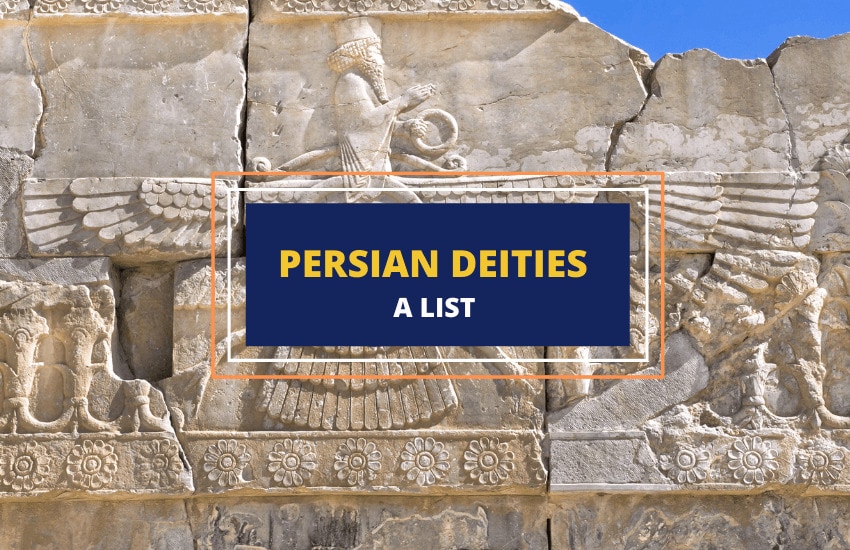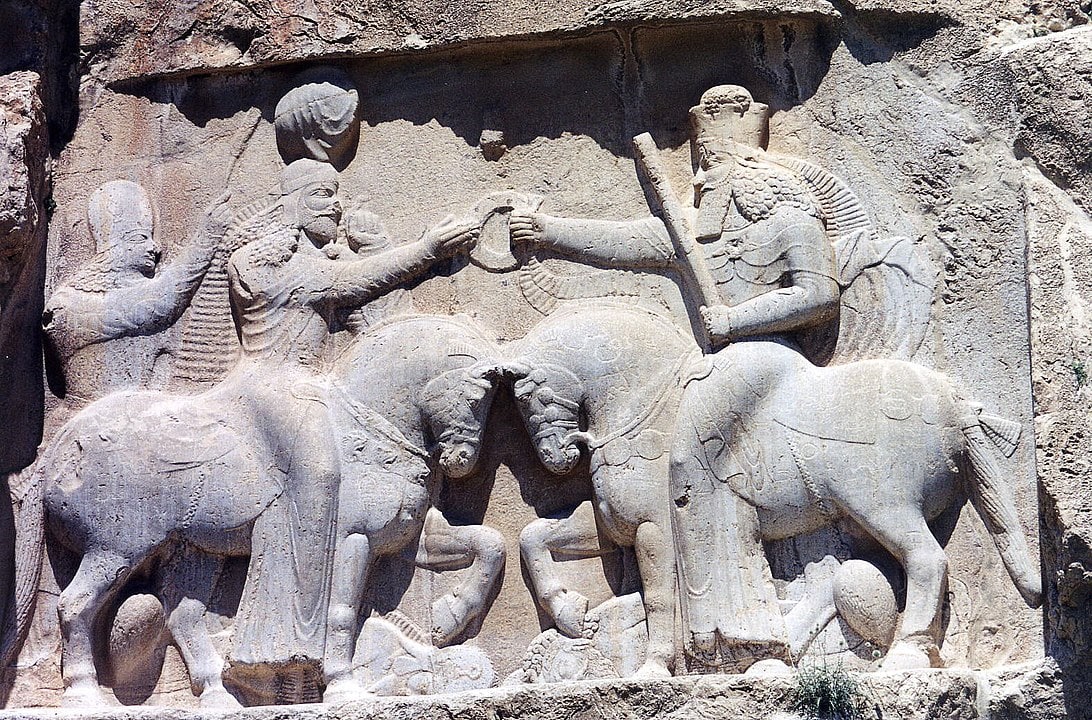
Table of Contents
Ancient Persian religion (also called Iranian paganism) existed before Zoroastrianism became the main religion of the region. While there is very little written evidence of the Persian religion and how it was practised, what little information gleaned from Iranian, Babylonian, and Greek accounts have made it possible for us to gain a fairly good understanding of it.
The Persian religion featured a large number of gods and goddesses, with Ahura Mazda as the main deity, who led all the others. Many of these deities would later be incorporated into the Zoroaster faith, as aspects of Ahura Mazda, the supreme deity.
Here are some of the most important Persian deities and the roles they played in their mythology.
1. Ahura Mazda (King of the Gods)

Ahura Mazda (also called Ormuzd) is the main god of the ancient Iranians and Zoroastrians, and a symbol of purity, redemption, and wisdom. He is the creator of the world and brought all things into existence.
It’s Ahura Mazda who decides who goes to heaven or hell based on their deeds on earth. He continuously fights against evil and darkness. He is always at war with the devil, Angra Mainyu.
According to the myth, Ahura Mazda created the first humans, who were then corrupted by the devil. While they were then barred from paradise, their children were given free will to choose good or evil for themselves.
In the Avestan calendar of the ancient Iranians, the first day of each month was called Ahuramazda.
2. Anahita (The Goddess of the Waters on the Earth)
In almost all ancient religions, the source of life and fertility is depicted as a female being. In Iran, the goddess, whose earlier and complete form was Aredvi Sura Anahita, held this position.
Anahita is the ancient Persian goddess of fertility, water, health, and healing, andwisdom. She is sometimes known as a goddess of war, as warriors would invoke her blessings for survival and victory before battles.
Anahita was the goddess of fertility and growth. By her will, rain fell, and rivers flowed, the plants grew, and animals and humans procreated.
Anahita is described as being powerful, radiant, lofty, tall, beautiful, pure, and free. Her depictions show her with a golden crown of eight hundred stars on her head, a flowing robe, and a golden necklace around her neck.
3. Mithra (The God of the Sun)
One of the earliest deities of Iran, Mithra was a popular and important god. He was worshipped as the god of the rising sun, of love, friendship, covenants, honesty, and much more. It is Mithra who ensures the order of all things. In addition to this, Mithra oversees the law and protects the truth, and as such was seen as the deity who gave rulers divine authority to rule.
Mitra oversees human, their actions, agreements, and contracts. He guides people on to the right path and protects them from evil, while maintaining order of night and day and the change of seasons.
4. Haoma (God of Health)
Haoma refers to both a plant and a Persian god. As a god, Haoma was credited with bestowing health and strength, and was the god of the harvest, vitality, and the personification of the plant. He is one of the oldest and most honorable gods of ancient Iran, and people prayed to him for sons.
The name of the deity was derived from the Haoma plant, said to have healing properties. In some legends, it’s said that the extract of this plant gave supernatural powers to humans. The plant was used to make an intoxicating drink, a feeling which was considered to be quality of the gods. The juices of the Haoma plant was thought to bring enlightenment.
5. Sraosha (God of the messenger and guardian of man)
Sraosha is one of the most popular figures in ancient Iranian beliefs. Sraosha is the deity of religious obedience, who was created by Ahura Mazda as one of his first creations. He is a messenger and the mediator between the gods and the people. The name Sraosha (also called Sarush, Srosh, or Sarosh) means information, obedience, and discipline.
Sraosha is one of the great gods who cares about the order of the world and is the guardian angel of the Zoroastrians. He was also the first creation of Ahura Mazda.
According to some sources, Sraosha and Mitra together guard the covenants and order. On the Day of Judgment, the two gods stand together to ensure that justice is served.
6. Azar (The God of Fire)
Azar (also called Atar) was the god of fire and was fire itself. He was the son of Ahura Mazda. Fire was an important element in the Persian religion, and as such, Azar played an important role. Later on, fire would become an integral aspect of Ahura Mazda under Zoroastrianism.
Azar is a symbol of true order, and one of the helpers of the army of heaven who fights for good. In the Avestan calendar, the ninth day of each month and the ninth month of each year are named after this god.
In ancient Iran, a festival called Azargan was held on the ninth day of the ninth month of each year came. In myths, Azar has fought against dragons and demons in battles he has waged to eradicate evil, and has won.
7. Vohu Mana (The God of Knowledge)
Vohu Mana, also known as Vahman or Bahman, is the protector of animals. The name Bahman means he who has good deeds. In the myths, Vohu Mana is depicted on the right side of Ahura Mazda and acts almost as a consultant.
Vohu Mana as “good thought” is the manifestation of god’s wisdom that is active in human beings and leads humans to god. The gods of the moon, Gosh and Ram, are his colleagues. His main opponent is a demon named Aquan.
Later on, in Zoroastrianism, Vohu Mana is depicted as one of the first six beings created by Ahura Mazda, the supreme deity, to help him in destroying evil and advancing good.
8. Zorvan (The God of Time and Destiny)
Zorvan, also called Zurvan, was a god of time and destiny. Initially, he played a small role in the large pantheon of Persian gods, but in Zoroastrianism, Zorvan takes on a much more significant position as the supreme deity who created all things, including Ahura Mazda.
The ancient Iranians believe that Zorvan was the creator of light and darkness, namely Ahura Mazda and his antagonist, Angra Mainyu the devil.
According to the myth, Zorvan meditated for a thousand years in order to give birth to a child who would create the world. After nine hundred and ninety-nine years, Zorvan began to whether doubt these meditations and prayers were useful.
Shortly afterwards, Zorvan had two children. Ahuramazda was born from Zorvan’s meditations and good thoughts, but Angra Mainyu was born from the doubts.
9. Vayu (The God of Wind/Atmosphere)
Vayu, also known as Vayu-Vata, is the god of wind, or atmosphere, often depicted as having dual natures. On the one hand, Vayu is the bringer of rain and life, and on the other hand, he is a terrifying, uncontrollable character associated with death. He is a benefactor, and at the same time, he can destroy everything and everyone with his destructive power. Because Vayu is the wind, he travels in both the good and wicked realms, and is both angelic and demonic at the same time.
These associations come from Vayu’s nature as the atmosphere or wind. He is both the guardian of the air and the demon manifestation of unclean and harmful air. He creates life by providing rains through rainy clouds, but at the same time, he takes life through destructive storms that cause death.
Vayu is depicted as a warrior, holding a spear and golden weapons, ready to rush into battle against the forces of evil, but depending on which way the wind blows, he could turn around and battle the forces of light.
10. Rashnu (God of Justice)
Rashnu was an angel, rather than a good, who presided over the souls of the dead, along with Mithra and Sraosha. He stood on the Chinvat Bridge, which spanned the realms of the afterlife and the human world. It was Rashnu who would read the records of a person’s deeds accumulated over their lifetime, and then judge whether that person would go to paradise or hell. His decision was always considered fair and just, and once given, the soul would be able to move on to its final home.
11. Angra Mainyu (Embodiment of Evil, Discord, and Chaos)
Angra Mainyu, also known as Ahriman, is the devil and evil spirit in the Persian religion. He battles against light and all that is good, and therefore his eternal opponent is Ahura Mazda. Angra Mainyu is the leader of demons and dark spirits, called devas.
Angra Mainyu is the brother of Ahura Mazda and is mentioned in most ancient Iranian stories. In the myths, humans and other good gods and creatures, all created by Ahura Mazda, are portrayed as being in a cosmic quest to triumph over evil in the fight against demons. Eventually, the devil is destroyed and Ahura Mazda dominates him.
Wrapping Up
Although there are scant written records of the ancient Persian religion, the little that we know opens up one of the world’s earliest religions full of colorful deities, both good and evil. Each god had its own domains of expertise and would look after those who sought assistance within those specific areas. Many of these deities would live on in the new religion, Zoroastrianism, as aspects of the supreme being Ahura Mazda.





